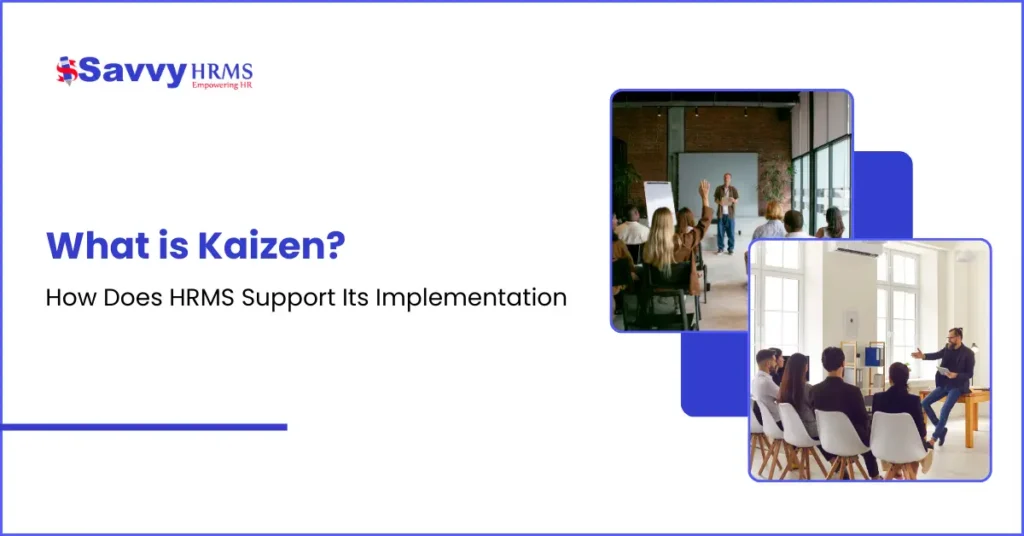Continuous improvement is important for every organization, focusing on staying competitive in the modern business environment. Small and ongoing changes can result in significant improvements in productivity, quality, and employee satisfaction. This mindset encourages everyone in the organization to contribute ideas and participate in regular development.
This approach builds a culture of teamwork and innovation, where even small adjustments add up to meaningful results progressively. It helps to reduce waste, increase efficiency, and boost employee engagement. By empowering individuals to recognize problems and suggest solutions, organizations create an active workforce that is ready for change.
Technology such as HRMS in continuous improvement efforts smooth workflows and ensure precise management of data. HRMS provides real-time analytics and automates daily tasks, allowing more focus on strategic planning for the organization. This combination of methodology and technology creates an environment where continuous progress is achievable.
What is Kaizen?
Kaizen is a Japanese philosophy that means “change for the better” or continuous improvement. It inspires making small and daily improvements in all areas of a business to enhance efficiency, quality, and employee engagement. Unlike other changes, Kaizen focuses on moderate advancement driven by everyone from the management team to employees.
This process boosts a culture of teamwork, problem-solving, and ongoing progress. By regularly identifying and solving problems, organizations reduce time and improve processes precisely. Kaizen empowers employees to contribute their ideas, creating a workplace where improvements are constant, and the organization achieves growth.
What are the 4 pillars of Kaizen?
The 4 pillars of Kaizen are purpose, process, people, and performance. These principles guide continuous improvement within the organization. Let’s read about each pillar below:
1. Purpose
Every successful Kaizen initiative begins with a well-defined purpose. It puts a clear vision and perfectly aligns improvement efforts with the goal of the overall organization. This process motivates employees and ensures all activities contribute significantly to the organization’s mission.
- Sets clear goals and direction for employee improvements.
- Aligns continuous improvement with company objectives.
- Motivates employees with a shared vision.
- Creates purpose based on daily tasks and initiatives.
- Instruct decision-making and prioritization for organizational growth.
2. Process
Process is the heart of Kaizen, concentrating on analyzing the present system to identify inefficiencies and opportunities for improvement. Organizing and improving the processes helps reduce waste, errors, and differences, ensuring consistent quality and better productivity within the organization.
- Examine workflows for incompetence.
- Regulates best practices to maintain overall quality.
- Eliminate waste and repetitions in operations.
- Enables smooth and effective task implementation.
- Promotes problem-solving and repeated refinement.
3. People
People are the operating power behind Kaizen. Engaging and empowering every employee boosts a culture of foundation, collaboration, and responsibility. When employees take ownership of their improvements, the changes are more sustainable and effective.
- Empowers employees to focus on the area of improvement.
- Create ownership and accountability across teams.
- Promotes collaboration and open communication.
- Supports continuous employee improvement.
- Boosts problem-solving and a motivated workforce.
4. Performance
Measuring performance is important to evaluate the success of Kaizen efforts. Tracking results regularly provides data-driven feedback, helping organizations improve processes and maintain improvements gradually, ensuring alignment with the organizational goals and objectives.
- Evaluate outcomes of improvement initiatives.
- Provides regular feedback for in-progress adjustments.
- Ensures the long-lasting impact of changes.
- Tracks progress toward organizational goals.
- Improves accountability and transparency.
What are the key principles of Kaizen?
1. Continuous and Incremental Improvement
Kaizen encourages making small and ongoing improvements rather than big changes, ensuring constant progress. HRMS supports this by automating HR tasks and enabling regular performance reviews, which promote repeated enhancements and assist growth within the employees of the organization.
2. Employee Involvement
Participation of every employee in improvement action boosts ownership and innovation. HRMS empowers employees through self-service portals and communication tools, allowing them to contribute ideas and participate actively in the live projects for continuous improvement.
3. Standardization
Setting up systematic procedures ensures compatible quality and operational efficiency. HRMS executes uniformity through automated attendance, payroll, and compliance processes, helping them to maintain best practices across the organization.
4. Data-Driven Decision Making
Successful improvement depends on accurate data and measures to guide performance. HRMS offers real-time dashboards and insights, enabling managers to monitor key HR measures, identify issues, and make informed decisions that drive positive change in the organization.
5. Waste Elimination
Kaizen looks to remove useless activities to improve productivity. HRMS minimizes waste by simplifying manual HR tasks, reducing errors, and allowing time for strategic plans. This boosts the culture of continuous improvement and operational excellence.
HR Software like Savvy HRMS supports Kaizen by automating daily HR tasks, providing precise data insights for informed decision-making, encouraging employee engagement through self-service portals, systemizing HR workflows, and boosting transparent communication. This integration makes continuous improvement controllable and rooted in daily organizational functions.
How does Kaizen work?
1. Identify Problems and Opportunities
The first step in Kaizen is recognizing particular areas that require improvement. This process includes careful observation and feedback from employees who deal with operations regularly. Determine real issues, ensure efforts target effective areas, and set the stage for applicable changes.
2. Analyze Current Processes
After identifying issues, the current state of employee engagement is analyzed in detail. Using techniques like process mapping and fundamental cause analysis, employees disclose inefficiencies and basic issues, allowing them to focus on the key causes rather than surface symptoms.
3. Develop Solutions
Employees collaborate to create practical and innovative solutions. These solutions point to simplifying tasks, eliminating waste, or improving quality. By considering different viewpoints, the team crafts practical plans that can be easily tested and polished.
4. Implement Changes
Improvements are introduced on a small scale to reduce risk. lead programs or limited implementation helps to observe the real-world impact and gather feedback. Adjustments are made as needed before full-scale acceptance to ensure effectiveness.
5. Monitor and Measure Results
Once it is implemented, constant monitoring using key performance measures helps to evaluate success. Collecting data and feedback enables organizations to understand the benefits discovered and identify areas for further improvement.
6. Standardize Successful Practices
When solutions are found to be effective, they are regulated and incorporated into organizational procedures. Training and documentation ensure consistent application and continuity, preventing a return to old habits.
7. Repeat the Cycle
Kaizen is an in progress process, encouraging continuous evaluation and improvement. By repeating these steps, organizations boost a culture of adaptability, innovation, and constant progress.
Savvy HRMS enhances each step by automating data collection, facilitating communication, providing insights for data-driven decisions, and enabling employee engagement, all are important to making Kaizen practical and effective in modern organizations.
Conclusion
Kaizen is a proven process that encourages continuous and small improvements that add up to major success progressively. Including everyone in the organization creates a collaborative environment where efficiency, quality, and satisfaction grow naturally.
When integrated with Savvy HRMS, Kaizen becomes even more effective. As it simplifies data management, enhances communication, and provides instant analytics, it makes it easier to track employee progress and keep the process going. Together, they empower organizations to grow stronger, smarter, and more flexible in this modern business world.


